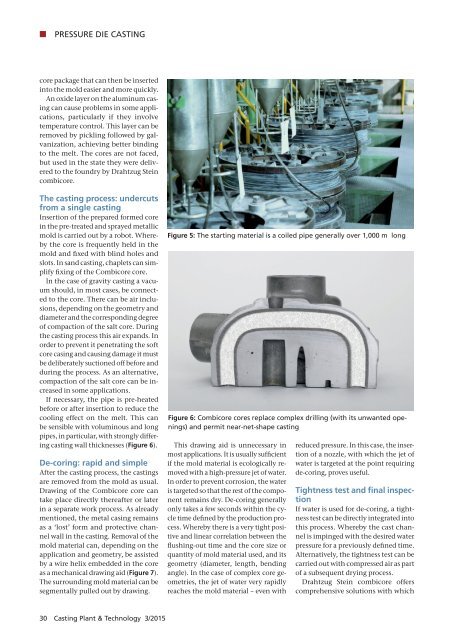CPT International 03/2015
The leading technical journal for the global foundry industry – Das führende Fachmagazin für die weltweite Gießerei-Industrie
The leading technical journal for the
global foundry industry – Das führende Fachmagazin für die
weltweite Gießerei-Industrie
You also want an ePaper? Increase the reach of your titles
YUMPU automatically turns print PDFs into web optimized ePapers that Google loves.
PRESSURE DIE CASTING<br />
core package that can then be inserted<br />
into the mold easier and more quickly.<br />
An oxide layer on the aluminum casing<br />
can cause problems in some applications,<br />
particularly if they involve<br />
temperature control. This layer can be<br />
removed by pickling followed by galvanization,<br />
achieving better binding<br />
to the melt. The cores are not faced,<br />
but used in the state they were delivered<br />
to the foundry by Drahtzug Stein<br />
combicore.<br />
<br />
from a single casting<br />
Insertion of the prepared formed core<br />
in the pre-treated and sprayed metallic<br />
mold is carried out by a robot. Whereby<br />
the core is frequently held in the<br />
mold and fixed with blind holes and<br />
slots. In sand casting, chaplets can simplify<br />
fixing of the Combicore core.<br />
In the case of gravity casting a vacuum<br />
should, in most cases, be connected<br />
to the core. There can be air inclusions,<br />
depending on the geometry and<br />
diameter and the corresponding degree<br />
of compaction of the salt core. During<br />
the casting process this air expands. In<br />
order to prevent it penetrating the soft<br />
core casing and causing damage it must<br />
be deliberately suctioned off before and<br />
during the process. As an alternative,<br />
compaction of the salt core can be increased<br />
in some applications.<br />
If necessary, the pipe is pre-heated<br />
before or after insertion to reduce the<br />
cooling effect on the melt. This can<br />
be sensible with voluminous and long<br />
pipes, in particular, with strongly differing<br />
casting wall thicknesses (Figure 6).<br />
<br />
After the casting process, the castings<br />
are removed from the mold as usual.<br />
Drawing of the Combicore core can<br />
take place directly thereafter or later<br />
in a separate work process. As already<br />
mentioned, the metal casing remains<br />
as a ‘lost’ form and protective channel<br />
wall in the casting. Removal of the<br />
mold material can, depending on the<br />
application and geometry, be assisted<br />
by a wire helix embedded in the core<br />
as a mechanical drawing aid (Figure 7).<br />
The surrounding mold material can be<br />
segmentally pulled out by drawing.<br />
The starting material is a coiled pipe generally over 1,000 m long<br />
Figure 6: Combicore cores replace complex drilling (with its unwanted openings)<br />
and permit near-net-shape casting<br />
This drawing aid is unnecessary in<br />
most applications. It is usually sufficient<br />
if the mold material is ecologically removed<br />
with a high-pressure jet of water.<br />
In order to prevent corrosion, the water<br />
is targeted so that the rest of the component<br />
remains dry. De-coring generally<br />
only takes a few seconds within the cycle<br />
time defined by the production process.<br />
Whereby there is a very tight positive<br />
and linear correlation between the<br />
flushing-out time and the core size or<br />
quantity of mold material used, and its<br />
geometry (diameter, length, bending<br />
angle). In the case of complex core geometries,<br />
the jet of water very rapidly<br />
reaches the mold material – even with<br />
reduced pressure. In this case, the insertion<br />
of a nozzle, with which the jet of<br />
water is targeted at the point requiring<br />
de-coring, proves useful.<br />
<br />
tion<br />
If water is used for de-coring, a tightness<br />
test can be directly integrated into<br />
this process. Whereby the cast channel<br />
is impinged with the desired water<br />
pressure for a previously defined time.<br />
Alternatively, the tightness test can be<br />
carried out with compressed air as part<br />
of a subsequent drying process.<br />
Drahtzug Stein combicore offers<br />
comprehensive solutions with which<br />
30 Casting Plant & Technology 3/<strong>2015</strong>


















